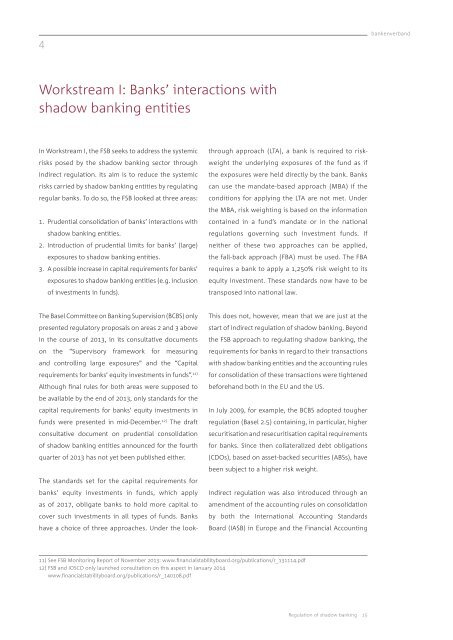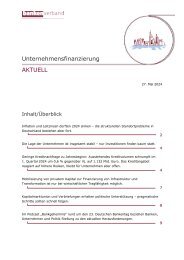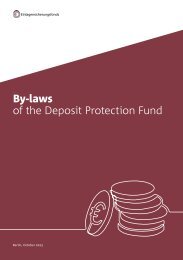Regulation of shadow banking
Shadow banking is given a large share of the blame for the financial crisis. This perception raises the question of what kind of shadow banking system should remain in place in the future.
Shadow banking is given a large share of the blame for the financial crisis. This perception raises the question of what kind of shadow banking system should remain in place in the future.
You also want an ePaper? Increase the reach of your titles
YUMPU automatically turns print PDFs into web optimized ePapers that Google loves.
4<br />
bankenverband<br />
Workstream I: Banks’ interactions with<br />
<strong>shadow</strong> <strong>banking</strong> entities<br />
In Workstream I, the FSB seeks to address the systemic<br />
risks posed by the <strong>shadow</strong> <strong>banking</strong> sector through<br />
indirect regulation. Its aim is to reduce the systemic<br />
risks carried by <strong>shadow</strong> <strong>banking</strong> entities by regulating<br />
regular banks. To do so, the FSB looked at three areas:<br />
1. Prudential consolidation <strong>of</strong> banks’ interactions with<br />
<strong>shadow</strong> <strong>banking</strong> entities.<br />
2. Introduction <strong>of</strong> prudential limits for banks’ (large)<br />
exposures to <strong>shadow</strong> <strong>banking</strong> entities.<br />
3. A possible increase in capital requirements for banks’<br />
exposures to <strong>shadow</strong> <strong>banking</strong> entities (e.g. inclusion<br />
<strong>of</strong> investments in funds).<br />
through approach (LTA), a bank is required to riskweight<br />
the underlying exposures <strong>of</strong> the fund as if<br />
the exposures were held directly by the bank. Banks<br />
can use the mandate-based approach (MBA) if the<br />
conditions for applying the LTA are not met. Under<br />
the MBA, risk weighting is based on the information<br />
contained in a fund’s mandate or in the national<br />
regulations governing such investment funds. If<br />
neither <strong>of</strong> these two approaches can be applied,<br />
the fall-back approach (FBA) must be used. The FBA<br />
requires a bank to apply a 1,250% risk weight to its<br />
equity investment. These standards now have to be<br />
transposed into national law.<br />
The Basel Committee on Banking Supervision (BCBS) only<br />
presented regulatory proposals on areas 2 and 3 above<br />
in the course <strong>of</strong> 2013, in its consultative documents<br />
on the “Supervisory framework for measuring<br />
and controlling large exposures” and the “Capital<br />
requirements for banks’ equity investments in funds”. 11)<br />
Although final rules for both areas were supposed to<br />
be available by the end <strong>of</strong> 2013, only standards for the<br />
capital requirements for banks’ equity investments in<br />
funds were presented in mid-December. 12) The draft<br />
consultative document on prudential consolidation<br />
<strong>of</strong> <strong>shadow</strong> <strong>banking</strong> entities announced for the fourth<br />
quarter <strong>of</strong> 2013 has not yet been published either.<br />
The standards set for the capital requirements for<br />
banks’ equity investments in funds, which apply<br />
as <strong>of</strong> 2017, obligate banks to hold more capital to<br />
cover such investments in all types <strong>of</strong> funds. Banks<br />
have a choice <strong>of</strong> three approaches. Under the look-<br />
This does not, however, mean that we are just at the<br />
start <strong>of</strong> indirect regulation <strong>of</strong> <strong>shadow</strong> <strong>banking</strong>. Beyond<br />
the FSB approach to regulating <strong>shadow</strong> <strong>banking</strong>, the<br />
requirements for banks in regard to their transactions<br />
with <strong>shadow</strong> <strong>banking</strong> entities and the accounting rules<br />
for consolidation <strong>of</strong> these transactions were tightened<br />
beforehand both in the EU and the US.<br />
In July 2009, for example, the BCBS adopted tougher<br />
regulation (Basel 2.5) containing, in particular, higher<br />
securitisation and resecuritisation capital requirements<br />
for banks. Since then collateralized debt obligations<br />
(CDOs), based on asset-backed securities (ABSs), have<br />
been subject to a higher risk weight.<br />
Indirect regulation was also introduced through an<br />
amendment <strong>of</strong> the accounting rules on consolidation<br />
by both the International Accounting Standards<br />
Board (IASB) in Europe and the Financial Accounting<br />
11) See FSB Monitoring Report <strong>of</strong> November 2013: www.financialstabilityboard.org/publications/r_131114.pdf<br />
12) FSB and IOSCO only launched consultation on this aspect in January 2014<br />
www.financialstabilityboard.org/publications/r_140108.pdf<br />
<strong>Regulation</strong> <strong>of</strong> <strong>shadow</strong> <strong>banking</strong> 15


















